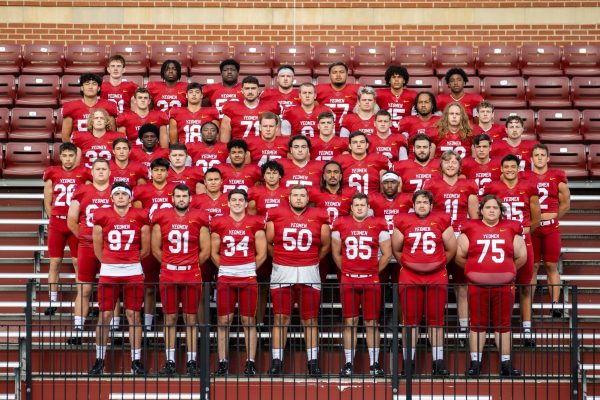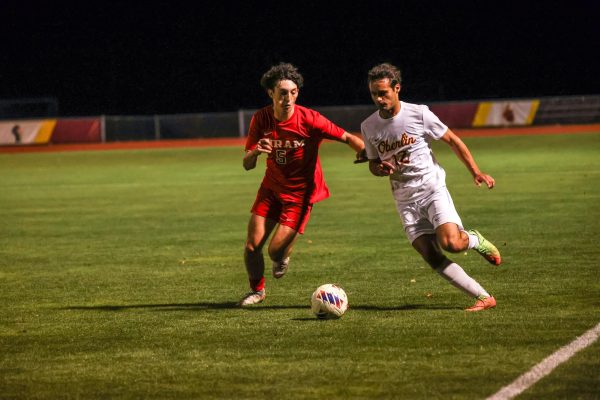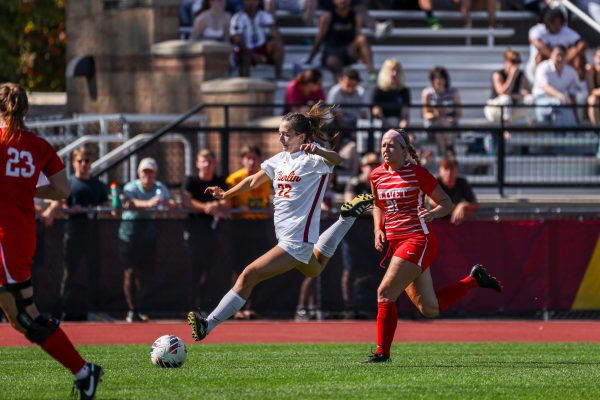Inspired By Myles Garrett, Athletes Join Aggression Debate
Over the course of the last month, several high profile sports leagues and the NCAA have seen suspensions handed out due to fighting. In the NBA, the Philadelphia 76ers’ Joel Embiid and Minnesota Timberwolves’ Karl- Anthony Towns got into a fistfight during a game in October, leading to both players missing key time. This past Saturday, University of Georgia wide receiver, George Pickens, was ejected after fighting Georgia Tech defensive back Tre Swilling.
These incidents bookended an all-out brawl that occurred between the Pittsburgh Steelers and the Cleveland Browns on Nov. 14, which culminated in Browns defensive end Myles Garrett hitting Steelers quarterback Mason Rudolph in the head with Rudolph’s helmet. These highly publicized incidents have opened up a discussion about the place of aggression and violence in sports.
“[Aggression is] in every play of every day,” said College third-year and football player Thomas Heffer. “You can’t hit a man standing across from you with success without being aggressive. It is preached as the third element of football, along with technique and effort.”
Heffer is right. Some sports, like football, require physical aggression in order to be effective — but not all. College third-year Elliot Nuss, a member of the men’s tennis team, would agree that levels of aggression vary from sport to sport.
“On the tennis court, you rarely see any physical aggression between competitors,” he said. “For the most part, there is more of a psychological and mental battle going on out there.”
Nuss highlights a key point. Usually, aggression is only viewed as physical, as in the cases mentioned earlier, but it can take many other forms. Mental, emotional, and verbal aggression are all present in athletics, each leaving a different imprint on the competition.
College third-year Kiera Markham, a women’s soccer player, sees a lot of verbal aggression in her sport and believes it can alter how the game is played.
“Certain teams and games are more tense than others and tend to produce more aggressive behavior,” said Markham, “I think that the fans play a major role in the verbal aggression that can happen during games. If you’re playing against a team whose student section is loud and is chirping, the more aggressive the game tends to be.”
Some sports, like track and field, have barriers that prevent athletes from being physically aggressive with one another. College third-year Cameron Macintyre, a member of the men’s track and field team, thinks this can lead to aggression being channeled into other areas.
“Aggression can take the form of confidence, determination and, in some cases, more toxic attitudes,” Macintyre said. “Cockiness is not something that track shies away from, [and] this may be because of the lack of physical aggression.”
Clearly, aggression, in its many different forms, is a part of athletic culture. That said, there has to be a line. Most people would concur that Towns and Embiid, Swilling and Pickens, and Myles Garrett all crossed it. But when exactly does aggression shift from being acceptable within the parameters of a sport to becoming something dangerous? The answer is complicated.
“I think the definition of the line is dependent on the sport,” Nuss said. “Obviously, some sports are more physical than others, but I think it can be agreed that physical aggression crosses the line when it becomes evident that the deliberate use of physical force is excessive and clearly is causing or has the potential to cause harm.”
While Nuss views checking athletes’ aggression as a matter of safety, Heffer — a member of one of Oberlin’s higher-contact teams — views aggression as a necessary part of playing at a high level.
“The only line that exists is when your aggression starts to negatively impact your play,” Heffer said. “Every form of aggression that makes your play style more impactful without destroying form [is acceptable], but even that is a blurred line depending on an individual’s abilities and their coach.”
When discussing aggression in athletics, safety always comes up. Markham, like Nuss, thinks it is impossible to separate the two.
“I think that when a player is clearly injured or unwell, play should stop,” Markham said. “The health of players from both teams is much more important than the game. I think that players who deliberately seek out physically dangerous play completely cross the line. [That said,] when I see teams that are over-aggressive, I assume it’s to compensate for abilities they might be lacking.”
All of these differing opinions on the purpose and place of aggression in athletics begs the question: Is aggression a positive or a negative in sports?
“I think, as an outlet, aggression is an important thing in some sports,” Macintyre said. “I believe that using sports as a release for aggression, anger, stress, and other challenges is very important. And I believe that as an athlete, you can fuel a lot of your motivation and intensity through aggression. However … when it matters less about how to win, and more about physically beating the opponent— often by pushing the rules — I believe aggression is a negative.”
While Nuss does believe that there is no place for excessive physical aggression in athletics, he thinks appropriate levels of other forms of aggression are a little more flexible.
“Personally, I don’t think there really is much of a place for physical aggression that greatly exceeds the expected aggression level or falls outside rules of a sport,” Nuss said. “When it comes to other forms of aggression, I think that there is more of a place for trash talk and mental warfare.”
Aggression is regularly one of the most polarizing elements of competitive sports. Some fans think that athletes are too soft, going so far as to discredit certain sports for their perceived lack of aggression. Others think certain sports are overly aggressive and barbaric in nature. The truth, it seems, lies somewhere in between these two extremes. Aggression, physical or otherwise, whether you like it or not, is part of athletics. However, it is up to the individual to control it.
“Not all athletes are aggressive,” Macintyre said. “Sometimes they are only aggressive in their sport. I wouldn’t consider myself aggressive anywhere in life unless I was lined up next to the person in hurdles. And I believe that it is possible [for everyone] to reach a similar balance.”









